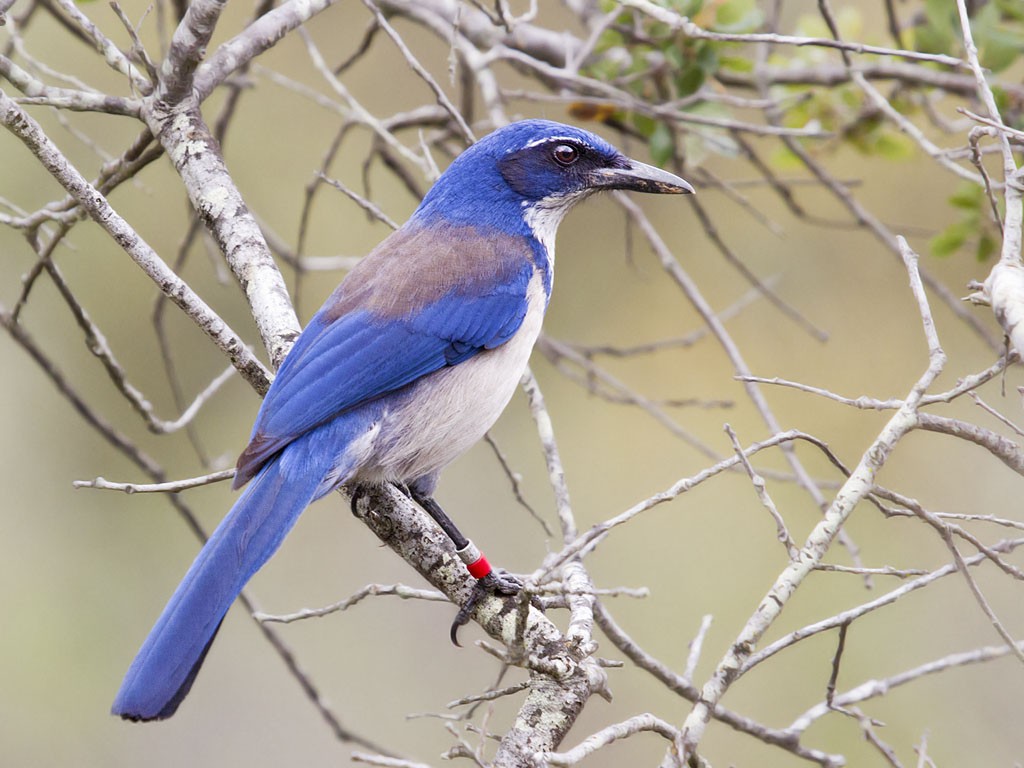Island Scrub-jay
A species of Scrub Jays Scientific name : Aphelocoma insularis Genus : Scrub Jays
Island Scrub-jay, A species of Scrub Jays
Botanical name: Aphelocoma insularis
Genus: Scrub Jays
Content
Description General Info
 Photo By Bill Bouton , used under CC-BY-SA-2.0 /Cropped and compressed from original
Photo By Bill Bouton , used under CC-BY-SA-2.0 /Cropped and compressed from original Description
The island scrub jay (Aphelocoma insularis) also island jay or Santa Cruz jay is a bird in the genus, Aphelocoma, which is endemic to Santa Cruz Island off the coast of Southern California. Of the over 500 breeding bird species in the continental U.S. and Canada, it is the only insular endemic landbird species. The island scrub jay (ISSJ) is closely related to the California scrub jay – the coastal population found on the adjacent mainland – but differs in being larger, more brightly colored, and having a markedly stouter bill. They will bury, or cache, the acorns in the fall and may eat them months later. They also eat insects, spiders, snakes, lizards, mice and other birds' eggs and nestlings. 
Size
28-33 cm (11-13 in)
Colors
Brown
Black
Gray
White
Blue
Life Expectancy
15 years
Nest Placement
Tree
Feeding Habits
Island Scrub-jay primarily eats acorns, seeds, insects, and fruit. It forages in trees and on the ground, often hiding food to eat later. Unique to this species is its specialized bill, allowing it to efficiently harvest and consume its staple acorn diet.
Habitat
The island Scrub-jay is primarily found in oak chaparral and bishop pine woodlands within a large island's nature reserve. They dwell in habitats rich with certain oak species and native shrubbery, extending to pine forests and areas with exotic plants. The landscape includes central valleys and north-facing slopes, with chaparral as the dominant vegetation type. Their habitat is diverse but geographically confined compared to relatives, and shows a resurgence of native flora over non-native grasslands.
Nest Behavior
The island Scrub-jay nests in isolated pairs and both sexes build the nest.
Nest Characteristics
Island Scrub-jay nests are bulky, thick-walled cups located 6-10 feet up in trees, usually oaks. They are constructed by both sexes using twigs, lined with fine rootlets, and occasionally animal hair.
Dite type
Omnivorous
General Info
Feeding Habits
Bird food type
Bird Feeder Type

Platform
Distribution Area
The island scrub jay is found only on Santa Cruz Island, the largest of California's Channel Islands with an area of 250 km (96 mi). The island is a nature reserve, the eastern 24% being administered by National Park Service as the part of the Channel Islands National Park and the rest of the island by the Nature Conservancy. Fossil remains for ISSJ have been found on Santa Rosa and San Miguel Islands. ISSJ occur in oak chaparral and bishop pine (Pinus muricata) woodland on Santa Cruz Island. ISSJ in pine habitat have longer, shallower bills than individuals in oak habitat; variation in bill shape is heritable, and individuals mate nonrandomly with respect to bill morphology. Females lay 3 to 5 eggs. Incubation lasts approximately 20 days. These jays are generally monogamous and, unlike some other jays, are not cooperative breeders. Both sexes build a nest 1 m (3 ft) to 8 m (26 ft) above the ground. Further details in . The genus name, Aphelocoma, comes from the Latinized Ancient Greek apheles- (from ἀφελής-) "simple" + Latin coma (from Greek kome κόμη) "hair", in reference to the lack of striped or banded feathers in this genus, compared to other jays. The species name, insularis, comes from the Latin for "from an island". 
Species Status
The island scrub jay is classed as vulnerable on the IUCN Red List because its small range makes it potentially vulnerable to a catastrophic incident such as disease or a large fire that destroys their habitat. Population size in 2008 and 2009 estimated to be 1700 - 2300, making this one of the rarest songbird species in the United States. The entire range of ISSJ is currently protected in Channel Islands National Park and the species is not at imminent risk of extinction. However, the establishment of West Nile virus (WNV) in southern California in 2003 may pose a threat if it crosses to Santa Cruz Island from the mainland. Corvids are especially vulnerable to WNV. In addition, the increased occurrence of wildfires in southern California may portend a catastrophic fire there. Shrub cover has increased since the removal of Santa Cruz sheep (1980–91) and feral pigs (2005–07) from Santa Cruz Island, which may increase the fire risk. Overgrazing by non-native ungulates may have caused extirpation of ISSJ on Santa Rosa Island. Re-establishing a second population of ISSJ on Santa Rosa Island may accelerate the restoration of native plant and tree species because of the scatter-hoarding seed caching behavior of Aphelocoma species. The Chumash people who were the original inhabitants of the northern Channel Islands may have eaten the local scrub jay, or used its feathers for decoration, since they are known to have made feather bands including jay feathers on the Californian mainland. Human activities may have contributed to the presumed extinction of the island scrub-jay from the smaller islands. 
Scientific Classification
Phylum
Chordates Class
Birds Order
Perching birds Family
Crows and jays Genus
Scrub Jays Species
Island Scrub-jay